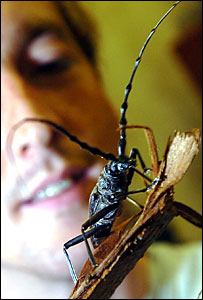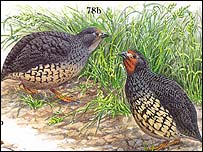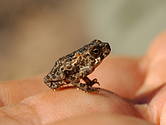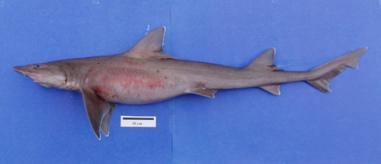Roundup of Amazing Finds
Posted by: Loren Coleman on July 1st, 2006
Some remarkable (yes, I do use that word) discoveries have flooded ye ole email in-boxes at Cryptomundo lately. The incoming announcements have been arriving so fast and furiously, I thought I would do a holiday weekend overview of several, to play catch up.
First, let’s begin with the smallest. Bernard Heuvelmans once defined cryptozoology as dealing with any animal that was big enough to be have an impact on humans. Most people have correctly viewed this as meaning the cryptid must be "ethnoknown," and has to be, generally, in the range of the size of a domestic cat or larger. However, a recent story from the United Kingdom suggests that if you are casually sitting in your favorite chair and a huge beetle walks across your living room floor, you might wish to pay attention.
Late in June, in Wales, a furniture restorer found a 2.6 inches long bug, with two antennae up to 4 inches long, in his shop. It turned out to be an extremely rare Capricorn beetle, apparently extinct in the U.K. since the 1700s.

Next, we should, at least note the saga of Bruno. In late May, when Bruno first wandered across the Italian and Austrian Alps into Germany, the media, officials and locals were excited by the first wild brown bear to be seen in the region for 170 years. But then the bear killed 30 sheep, several chickens, caged rabbits, and beehived bees. Enough was enough, so we are told, and late in June, Bruno was tracked down by five elkhounds, GPS instruments, and dispatched by four Finnish hunters. Bruno, it must be revealed if you examine the stories closely, was a bear that had been introduced into the Italian Alps, some time ago. There was nothing cryptozoological, at all, about Bruno.

Much more cryptozoological is the news of the rediscovery of a quail believed to have been extinct for nearly 80 years and now seen again by a prominent ornithologist in the north-eastern Indian state of Assam. The Manipur Bush-Quail was seen earlier in June 2006, by Anwaruddin Choudhury, a wildlife specialist. The rediscovery was being hailed as good news.
"Now I hope other ‘extinct birds’ may re-appear, such as the Himalayan Quail – thought to be extinct for 125 years – and the Pink Headed Duck which also had not been seen for a long time," the Wildlife Trust of India’s conservation director, Rahul Kaul, told the BBC.

Meanwhile in other bird news, the rare Pied-billed Grebe has been discovered to be breeding in New York State’s Stewart State Forest. According to the New York Department of Environmental Conservation they are claiming this is a threatened species discovered. "We are very excited about this bird and its nest. I have been looking for breeding evidence for at least four years," said a spokesperson for the department.

On an entirely different level of significance, it was announced on June 29, that a WWF expedition into the newly created Juruena National Park deep in the Amazon forest has found several potentially new species to science, including the pictured unidenitified (as yet) new tree frog species.
Altogether, the scientists found two new frogs, new fish and bird species, one new tree species and one new primate.

According to the WWF news, experts on the expedition came across 200 species of birds, ocelots, and a pink dolphin.

"Finding a pink dolphin was a complete surprise since we didn’t imagine that this animal lived in the area," said Claudio Maretti, WWF-Brazil’s Coordinator for Protected Areas.

The Amazon river dolphin, one of the world’s three freshwater dolphins, is widely distributed throughout much of the Amazon and Orinoco river basins. Its habitat, however, is threatened by river development projects, and is classified as vulnerable by the IUCN Red List of Threatened Species.

Sticking to the water theme, a new species of wobbegong shark has been found off the coast of southwestern Australia. The shark has just been described as Orectolobus hutchinsi in the latest issue of the systematics journal Zootaxa. Another new shark is pictured here:

Then in June, came word that a new species of hammerhead shark has been discovered in the north-western Atlantic off the coast of South Carolina.

Finally, in the realm of the wonders of the animal world being right near home, two weeks ago here in Portland, Maine, two moose (elk in Europe) decided on the same day to come down to the city’s Back Cove (next to Baxter Blvd) and take a dip. It only goes to show one that the wilderness, sometimes, does appear to be right outside the door.


Thanks to some of the above sent in by Cryptomundo Informant Chris Rehberg.
About Loren Coleman
Loren Coleman is one of the world’s leading cryptozoologists, some say “the” leading living cryptozoologist. Certainly, he is acknowledged as the current living American researcher and writer who has most popularized cryptozoology in the late 20th and early 21st centuries.
Starting his fieldwork and investigations in 1960, after traveling and trekking extensively in pursuit of cryptozoological mysteries, Coleman began writing to share his experiences in 1969. An honorary member of Ivan T. Sanderson’s Society for the Investigation of the Unexplained in the 1970s, Coleman has been bestowed with similar honorary memberships of the North Idaho College Cryptozoology Club in 1983, and in subsequent years, that of the British Columbia Scientific Cryptozoology Club, CryptoSafari International, and other international organizations. He was also a Life Member and Benefactor of the International Society of Cryptozoology (now-defunct).
Loren Coleman’s daily blog, as a member of the Cryptomundo Team, served as an ongoing avenue of communication for the ever-growing body of cryptozoo news from 2005 through 2013. He returned as an infrequent contributor beginning Halloween week of 2015.
Coleman is the founder in 2003, and current director of the International Cryptozoology Museum in Portland, Maine.










Is the picture below the finding of Orectolobus hutchinsi a photograph of a specimen? I ask because wobbegongs are camouflaged bottom feeders, often with frill growths and other similar adaptations including, generally, flattened bodies.
Say Loren,
My friend on Mass Ave woke to find one of the moose in his backyard. Looking up from his coffee he saw the moose looking right back at him through the kitchen window.
I had never heard of the pink dolphin..how wonderful !
sluggo
I live near there.
As in the Moose story.
Brilliant! This is what i love, even when we’re well on the way to destroying the earth and decimating global bio-diversity the natural world still throws suprises back in our face!
Not such a small world after all!
fitz (1) – I believe the photo is of “another new shark”. A practical fishkeeping article lists the species description paper as:
Last PR, Chidlow JA and LJV Compagno (2006) – A new wobbegong shark, Orectolobus hutchinsi n. sp. (Orectolobiformes: Orectolobidae) from southwestern Australia. Zootaxa 1239: 35-48.
The abstract and part of the introduction (but no illustrations) are available online.
I’m an avid birder, and Pied-billed Grebes are not “rare” anywhere in the United States. They’re common birds that live in ponds and marshes all over the United States (in fact I saw one just this Saturday). This information is available in any birder’s field guide, even those written for children. I have a keen interest in Cryptozoology but I’m afraid that articles like this one will do absolutely no good for its already shaky standing in the scientific community.
I tend to agree with arcanamundi about the lack of “rarity” of the grebe species, as noted, but that’s why I qualified what I was passing along in the news about it. Also, perhaps its “threatened status” only applies to New York State?
Anyway, this is why I quickly followed with my “on an entirely different level of significance” divider with the next story.
This was a “roundup,” after all, and stated as such, with different levels of importance.
I live in Munich, Germany and just thought I’d add a small correction to the story about the bear in the German Alps. Bruno wasn’t killed by the Finnish hunters. He was actually killed by a German hunter, the morning of the first day that hunters were given the go ahead to shoot and kill him. The Finnish bear hunters and their dogs didn’t seem to be able to track him down. It was pretty hot and humid here during the weeks they had the Finnish hunters here and I read in some news stories that the dogs were suffering from the heat and couldn’t track very well or long. Also, the Finnish hunters were just suppose to try to capture the bear and then he was going to be relocated. Unfortunately for “Bruno” that didn’t work out.
Well, that report by WWF and the pink dophins (called botas in amazonas) just about cements my view of WWF. My wife and I own a farm in para state, about 50 n/w of santarem and not to brag, but I’ve been traving around para and amazonas state since 1997 on amazonas (solimoes), rio negro, japura, mapuera and a whole bunch of other rivers I could name. Anyway…, those pink dophins are everywhere on the tributaries of the amazon river; I’ve had them swimming under my kayak on many occasions when I took it there in 1997 and seen them on about every river I’ve travelled on. For WWF to anounce a “discovery” that they’ve found them on a tributary of the amazon is like saying you “discovered” deer in oregon! What ABSOLUTE rubbish put out by an organization of media hounds. I could tell you another story of the director of WWF in the Republic of Congo (Paul Elkan) this year telling me there were no hippos left in the north of the country and then he argued with that I had seen any on the Ubangi River, until he saw the pictures! This character had been in ROC for 12 years and had never travelled to the ubangi to the area, but was sure there weren’t any there! Another quick antedote: Hugo, a young biologist w/WWF in the ROC said he’d been studying gorillas for 2 years, yet admitted he’d never even seen one yet! The fact of the matter is, that WWF makes up data and then doesn’t do its fieldwork until there is a “discovery” that they feel will make it in a paper somewhere. It’s amazing to me WWF has any credibility at all anymore.
figures see aminal kill aminal sometimes I hope BF never gets found it would be a very bad thing for him.